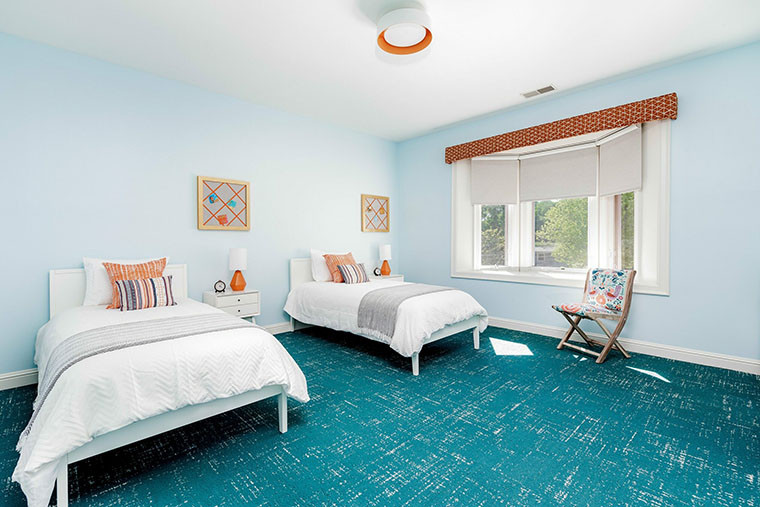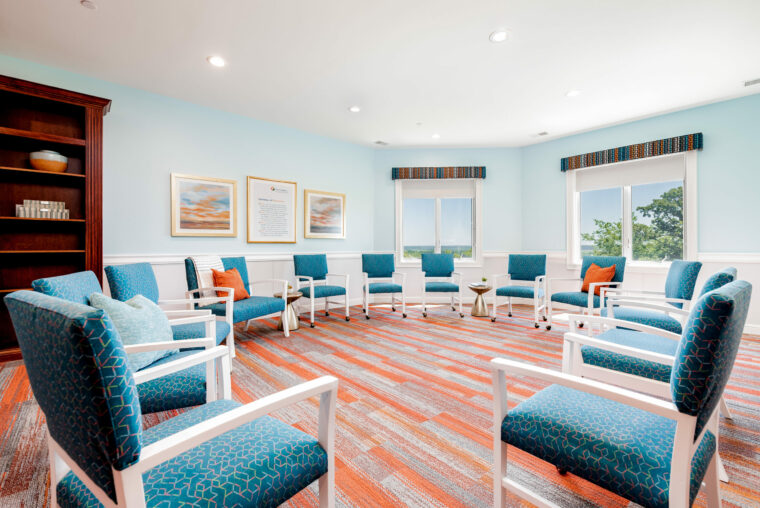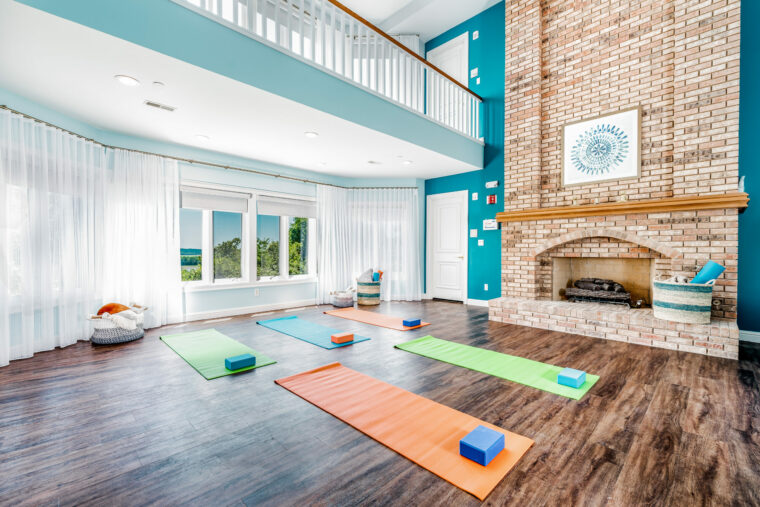Monte Nido & Affiliates adolescent program for eating disorder treatment, located in St. Louis, Missouri, is a residential treatment program exclusively for adolescents of all genders. The comprehensive care program includes options for adolescents seeking treatment for anorexia nervosa, bulimia nervosa, binge eating disorder, or exercise addiction, serving the treatment needs of adolescents in St. Louis and the surrounding areas. The program is also equipped to treat other eating disorders such as ARFID, OSFED, orthorexia nervosa, and many co-occurring mental health disorders.
Clementine Programs is thrilled to expand its coverage to the Midwest. Eating disorder recovery programs are needed everywhere; cases of disorders like bulimia nervosa, anorexia nervosa, and binge eating disorder affect all kinds of people. Through providing residential treatment for adolescents in St. Louis, we hope to help as many adolescents as possible.
Adolescent Eating Disorder Treatment in St. Louis
St. Louis has a metropolitan area population of about 2.6 million people and serves a much larger area in the Midwest. According to ANAD,9 percent of the US population will experience an eating disorder at some point in their lives. This leads to some alarming statistics (all stats from ANAD).
- The need for eating disorder treatment in St. Louis metro area may extend to almost 250,000 people
- Eating disorders are underreported in BIPOC – they are 50% less likely to be diagnosed correctly with anorexia nervosa, bulimia nervosa, or binge eating disorder
- LGBTQ people are much more likely to experience eating disorders than cisgender, heterosexual people – as much as seven times more likely
- Body image issues begin early – as much as 46 percent of 11-year-olds are “dieting” or controlling their caloric intake
These national trends are as true in St. Louis as anywhere else. In fact, since the coronavirus pandemic began in 2020, the need for eating disorder treatment in St. Louis has greatly increased. According to this report on NPR, Missouri’s eating disorder recovery helplines were inundated by calls during the lockdown period. Clementine’s St. Louis program is designed to handle all protocols in residential eating disorder treatment, as well as offering virtual services as part of aftercare.
Who Do We Treat?
Adolescence is the most likely age for eating disorders to develop. For those with anorexia and nervosa and bulimia nervosa, a recent study found that the average age on onset was 18 years old, therefore people begin to need treatment at an earlier age. Other disorders, especially binge eating disorder, may have a slightly higher average age of onset, but related disorders such as body dysmorphic disorder also usually begin during adolescence.
Because of this, programs like Clementine in St. Louis and many other locations have become specialized in treating adolescents. The age group of 12 – 18, in addition to being the prime demographic for eating disorder development, has very specific medical needs. Adolescent treatment requires careful planning when treating both medical complications and mental health conditions.
Eating disorders affect adolescents of all backgrounds. With that in mind, Clementine St Louis is prepared to provide treatment for:
- Adolescents of all genders. Clementine St. Louis proudly offers gender-affirming care that welcomes trans individuals and tailors their programs with gender-affirming care. Please contact our admissions specialists to learn about the specifics of both gender-inclusive and gender-exclusive programs and for details about housing and room assignments.
- Adolescents of all ethnicities. Clementine provides care to people in need of eating disorder recovery from all backgrounds.
- Adolescents of all socioeconomic backgrounds. Clementine programs recognize that each policy has its nuances; we look at the plan and person individually before admission to determine the financial scenario for each family.
- Every Clementine program is proud to be an LGBTQ-friendly facility, with informed care that includes personalized treatment programs.
Families are central to every eating disorder recovery program, and even more so when the client is an adolescent. Our programs include family programming that includes family therapy sessions that feature both the entire family and the parents. We also include family educational that helps the parents understand the challenges of eating disorder recovery, coordinating the client’s school and tutoring, and nutritional programming that can be applied when the client returns home.
What We Treat
Eating disorders come in multiple forms, and each of them can be harmful to a person’s development. Clementine programs are comprehensive, treat a wide range of eating disorders and other mental health conditions. Each of these disorders can be diagnosed by a psychiatrist, and the criteria can be found in the DSM-V. Among the conditions we address at our treatment center in St. Louis are:
- Anorexia Nervosa – A mental health condition where an individual restricts caloric intake in an effort to lose weight. A diagnosis of anorexia nervosa includes the individual becoming medically underweight; if they restrict food, have distorted body image, and lose weight but do not become underweight, it is diagnosed as atypical anorexia nervosa. Anorexia nervosa has the highest mortality rate of any mental health disorder. Anorexia treatment consists of medical stabilization, psychotherapy, and nutritional education.
- Bulimia Nervosa – Also associated with body image distortions and a desire to lose weight, bulimia nervosa consists of a person regularly binge eating and then following these episodes with purging in one form or another. Most often this means self-induced vomiting but can include methods like excessive exercise and abuse of laxatives or diuretics. Bulimia treatment involves behavioral therapy, psychotherapy, and mindfulness as well as medical treatment.
- Binge Eating Disorder – This is the kind of eating disorder most recently added to the DSM-V, but it is the most common eating disorder in the United States. Binge eating disorder is when an individual routinely eats a large amount of food in a short period, often past the point of feeling comfortable or full. Unlike bulimia nervosa, the individual does not purge following a binge eating episode. Binge eating treatment addresses the individual’s self-image distortions and provides nutritional education to help re-establish healthy eating patterns.
- Orthorexia Nervosa – Unlike the previously listed disorders, orthorexia nervosa is not necessarily associated with body image distortions. With this disorder, the individual develops an obsession with “clean” or “healthy” eating. They will cut out certain ingredients and food groups that are deemed unhealthy. It can result in malnutrition, weight loss, and social isolation. Orthorexia treatment involves nutritional education and cognitive therapy to correct the disordered obsession with “clean” eating.
- ARFID (Avoidant/Restrictive Food Intake Disorder) – Common in children but also continuing into adulthood, ARFID is a restriction of foods that negatively affects someone’s health. Unlike orthorexia nervosa, the motivation for this type of eating is not necessarily healthy eating, but rather an extreme dislike of the food based on flavor or because of imagined risk of perception of harm caused by eating that food. In some cases, ARFID can result in extreme weight loss, malnutrition, and other associated health concerns. ARFID treatment, similar to orthorexia treatment, includes behavioral therapy techniques and nutritional education.
- OSFED (Other Specified Feeding or Eating Disorders) – Formerly known as EDNOS, this disorder includes eating disorders that have some aspects of another eating disorder but does not meet the necessary diagnostic specifications. For example, a person who goes through periods of binging and purging, but not consistently enough to receive a diagnosis of bulimia nervosa may be diagnosed with OSFED. Atypical anorexia nervosa also fits in this category. When providing treatment for OSFED, the care team will examine the specific symptoms the individual is showing, and tailor the treatment plan accordingly.
Co-occurring Disorders
Eating disorders rarely exist in a vacuum; co-occurring disorders are exceedingly common. Some form of co-occurring mental health disorder is present in well over 50 percent of people with eating disorders. These may include:
- Psychiatric presentations (depression, anxiety, OCD, bipolar disorder, borderline personality disorder)–Eating disorders are psychiatric illnesses in and of themselves and are closely associated with these presentations. Comprehensive eating disorder treatment always makes a full assessment of each individual in treatment, to align treatment for each kind of condition. Psychotherapy is standard, and some mental health presentations such as depression and OCD can be controlled using medication.
- Trauma/PTSD –Disordered eating and other forms of disorder behavior are often a kind of trauma response. Because of this, trauma-informed care is central to virtually every eating disorder treatment program. Adolescent eating disorder treatment will often include mindfulness exercises and therapeutic techniques like Cognitive Processing Therapy (designed specifically to help people process trauma) to address the key root causes of disordered eating.
- Substance Use – Substance use disorder is also common in people with major depression, PTSD, and other psychiatric presentations, as well as in people with eating disorders. Many medicines such as diuretics and laxatives are abused as part of bulimia nervosa and/or anorexia.
Levels of Care for Eating Disorder Treatment
Treatment is normally classified into different levels of care.
- Residential treatment involves the client moving to the treatment facility to receive 24/7 focused care. This includes medical care, therapy, nutrition and meal planning, and mindful movement training. Excursions are frequent and the facilities are normally home-like and comfortable.
- Day treatment involves sessions online, in what’s known as virtual treatment sessions. While these programs may help coordinate necessary medical care, their focus is necessarily on therapy sessions. Clementine programs provide partial hospitalization (PHP) and intensive outpatient programs (IOP) levels of care. These programs are coordinated with the client’s local medical providers and therapists.
Program features at Clementine St. Louis include:
- Twice weekly individual psychotherapy sessions with doctoral or master’s level primary therapist
- Weekly individual sessions with members of the treatment team; including the clinical director, dietitian, psychiatrist, and family therapist
- Family involvement and empowerment: Close communication and direct access to treatment team | Weekly family therapy (on-site or remote). Weekly multi-family group (on-site). Individualized exposure opportunities to practice meals and support the reintegration of the adolescent into family mealtimes after discharge
- Daily group therapies such as Dialectical behavioral therapy, Cognitive behavioral therapy, Body image rehabilitation,art, and expressive therapies, family and relationships, interpersonal process, self-esteem, relapse prevention, contract groups
- Individualized treatment for co-occurring disorders such as substance use, mood disorders, trauma, etc.
- Individualized therapeutic assignments are given weekly and are tailored to the adolescents’ level in treatment. They are intended to promote awareness, understanding, and insight
- Supported Exposure Therapy:Weekly food challenges | Normalization of a wide variety of foods, grocery stores, and restaurants, outings could include: museums and bowling, activities could include: game and movie nights, free play, pottery, jewelry making
- Life Skills Development: Chores, hygiene, homework, journaling, relaxation and balance, time management and prioritization, peer pressure and assertiveness, school stress, communication, decision-making
- We understand movement and exercise are an important part of a balanced life. We ensure adolescents develop a mindful relationship with movement and their body by integrating movement, exercise, play, and life skills into programming. This involves weekly movement sessions, expressive movement therapy, games, and dance. More movement and exercise are allowed as the client progresses through the level system, and movement passes are allowed with family when appropriate
- Thorough Discharge and Aftercare Planning: Detailed comprehensive plans to support a successful return to home and school, step-down program support, academic reintegration plan, personalized meal and exercise plans, and referrals as needed to outpatient providers. In select areas, there is an opportunity to step down to a nearby Monte Nido & Affiliates partial hospitalization or intensive outpatient program, as needed, that will offer philosophical and programmatic continuity with Clementine St. Louis.

















